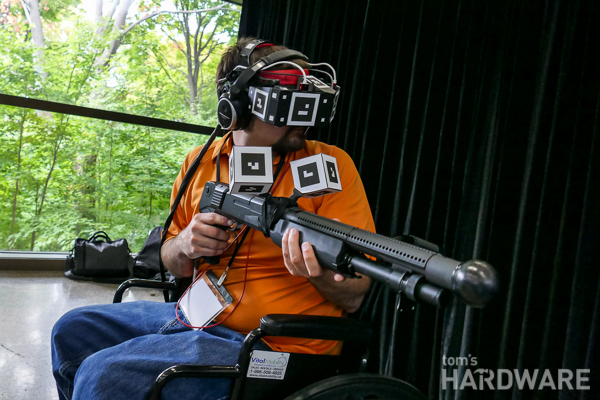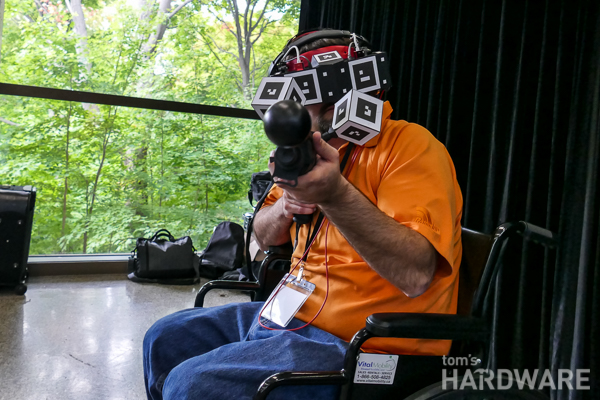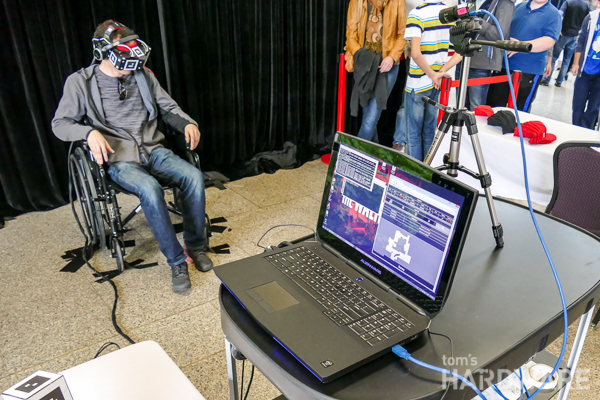VR Will Never Be The Same For Me: StarVR Has Shown Me The Future
The 2015 Immersed Toronto Conference kicked off on October 4 with a free public VR experience day at the Ontario Science Center. Among the companies in attendance showing off their wares is Starbreeze studios with its StarVR HMD.
We've talked about StarVR a couple of times now, and we even had someone try it already at Immersed Europe, but this time I had the chance to speak with some of the people working on the StarVR project and learn a little more about it, and what the plans are for the headset and the Walking Dead game that the company is developing to go with it.
Wide FOV Makes All The Difference
The major difference between StarVR compared to the other announced headsets is definitely the ultra-wide field of view. The headsets that are coming out next year -- Oculus, Vive and Playstation VR -- have a much narrower viewing angle. The Oculus CV1 FOV has not been revealed, but the DK2 is 100 degrees. HTC's consumer Vive headset has yet to be revealed, but the developer kits are capable of 110 degrees. StarVR boasts a comparatively ridiculous 210-degree FOV.
To achieve such a wide field of view, the StarVR headset features two 1440p panels mounted side by side, and at an angle. The company has developed a set of custom Fresnel lenses that make the image appear to wrap around your face. When I had the headset on, I was convinced that the screens they used are curved, but while talking with Guillaume Gouraud from Starbreeze Studios, he said that the screens are in fact flat, and it's the lenses that make them appear curved.
Before getting the chance to try it out, I was expecting the headset to be heavy. However, with two QHD displays, the headset effectively has double the hardware found in other headsets, although it does not feel like it. Starbreeze Studios reps said that the display is not as light as they hope to get it, but for a prototype, the company has done a great job keeping the weight down.
StarVR's head strap is quite different from the ones found on both the Rift and the Vive. The other headsets have fabric straps that can easily feel loose, whereas the StarVR uses a mechanically adjustable strap. A dial at the back is used to tighten the mount. It reminded me of the type of strap you would find on a welding mask.
Starbreeze said that the head strap will be quite different when the headset is released, but it will retain the dial mechanism. In my opinion, this is the right call. I've tried several different VR headsets, and this one felt the most secure.
Get Tom's Hardware's best news and in-depth reviews, straight to your inbox.
Once I had the headset strapped on, I immediately noticed how close the screen was to my face. The other VR HMDs that I've had the chance to try have somewhat of a diving goggle effect. The screens are away from your face, and the sides of the headset are visible in your peripheral vision. StarVR mounts the lenses much closer to your face. In fact, my eyelashes were actually touching the lenses when I blinked. The crew running the demo said this is normal for the prototype. The display is on a hinge, though, so it is possible to adjust the display so the lenses don't touch your face.
The effect of having the screen so close is quite impressive. StarVR's main selling point is the peripheral vision, and it truly delivers. I tried as hard as I could to make out the edges of the screen, but I was unable to. With the display on, your are fully immersed in the game.
Zombie Fodder
The demo being shown with the StarVR headset is a version of the upcoming Walking Dead game from Overkill, which Starbreeze is publishing. The game that Overkill is making isn't exactly this title, but the VR demo uses the same assets found in the full PC game. The VR demo is being built as a separate experience, but Starbreeze did say that it will eventually be available.
The Walking Dead VR experience has you sitting in a wheelchair, as your character is already injured by the time the demo starts. A character in the game pushes you along through the halls of what looks like a rundown office building or hospital. After a few minutes, things get hairy, and you are handed a shotgun (in the game, and in reality).
This is where the fun begins. Without giving too much away, suffice it to say that the zombies start coming, and the game starts to get a little intense. The demo ends when you run out of ammo. You can imagine what happens next.
StarVR uses fiduciary markers that are tracked by a camera. These markers are placed in various locations on the headset itself, as well as peripherals. This demo features a pump-action shotgun that has two cubes attached to it, with markers on all sides. These markers allow for the gun to be tracked in 3D space, and it worked quite well. Starbreeze said it can use these types of markers on any kind of peripheral you might want in VR.
The whole experience is really quite impressive, and it truly gave me a full immersion experience. I had to regain my bearings when I took the headset off. I wouldn't say it made me dizzy, but I definitely needed a moment to adjust to reality.
Issues: Clarity, FPS, Horsepower
Despite the incredible experience that it was, StarVR is not without its faults, although that's not unexpected for prototype hardware. One of the bigger issues is the clarity of the image. The headset might use dual QHD displays, but the close proximity to your face causes some distortion.
Another cause of distorted images is the frame rate. Starbreeze said that the demo runs at 60 frames per second, but from my experience, I would have to say that it needs to be improved. The visuals were a little blurry at times, especially when rotating my head. I didn't notice any significant drops in frame rate, but I wouldn't be surprised to find out that it did.
The system running the demo was a gaming laptop hooked up to an external breakout box housing a Titan X. If a Titan X is having that much trouble rendering the game, it will be some time before the average user has the power for a headset like StarVR.
Cost? Who Cares?
In talking with the representatives from Starbreeze, it was pretty clear that the company sees space for a premium headset in the market. The team is more interested in making the best possible VR experience, rather than focusing on the cost. Starbreeze wants to be the benchmark for high-end VR.
Starbreeze is not willing to talk about when the headset might see a retail release. For now, company reps are content showing what they have, and they noted that there is much research and development to be done. The company was not even willing to speculate when the headset could be seen -- not even if it would land in 2017. In any case, Starbreeze did say that the StarVR headset will not be a first-generation VR HMD, so we're looking at a bit of a wait still.
There's definitely more work to be done, but this type of advancement in VR is wonderful to see. The only problem is that now I've been spoiled. After experiencing such a wide field of view, going back to an Oculus Rift DK2 for my next demo left me feeling like I was wearing goggles -- something I never felt before trying StarVR.
Update 10/10/2015 12:45pm: The article was published with a type in Guillaume's family name. It has been corrected.
Follow Kevin Carbotte @pumcypuhoy. Follow us @tomshardware, on Facebook and on Google+.
Kevin Carbotte is a contributing writer for Tom's Hardware who primarily covers VR and AR hardware. He has been writing for us for more than four years.
-
cats_Paw You know nothing, john snow.Reply
Sorry wrong quote.
VR still ash a huge way to go (especially in horsepower required, think Unreal Engine 4, Infiltrator demo, open world AND VR).
According to rough estimates, we are talking 3-5 years at least until its affordable.
And that presumes the companies that have been making utter crap (triple A companies) will suddenly start to do good games. -
chicofehr I'm sure they will all have wide FOV soon. FOV is so important if you play triple monitor and using VR is like sitting close to 3 monitors. Narrow FOV can make you dizzy or nauseous so I can understand with 3x30" screens. I hope this makes more games have a proper FOV dial in the settings. Editing the ini or having to do a mod is annoying. Not sure how the older games will work with this.Reply -
Vorador2 To be blunt, the FOV is too wide. Human binocular FOV is 115º while full FOV is about 165º. This device has a FOV of 215º. While it's not a problem per se, you're wasting rendering power into parts of the screen you can't see. While a good driver could reduce this problem by lowering rendering quality on the edges of the screen, you're still paying for screen state you can't use.Reply
As i see it, we need to hit the 150-165º FOV, but more of that is a waste. -
alidan ReplyTo be blunt, the FOV is too wide. Human binocular FOV is 115º while full FOV is about 165º. This device has a FOV of 215º. While it's not a problem per se, you're wasting rendering power into parts of the screen you can't see. While a good driver could reduce this problem by lowering rendering quality on the edges of the screen, you're still paying for screen state you can't use.
As i see it, we need to hit the 150-165º FOV, but more of that is a waste.
im assuming they are also taking into account moving your eyes from left to right, so no matter where you look, you see screen. -
Vorador2 Replyim assuming they are also taking into account moving your eyes from left to right, so no matter where you look, you see screen.
Good optics and/or pupil tracking can take that into account. Oh well, we're still on the experimenting phase. There's time for refinements. -
jockemedw http://starbreeze.com/2015/09/starbreeze-in-collaboration-with-tobii-to-integrate-its-world-leading-eye-tracking-technology-into-the-unique-210-degree-5k-resolution-starvr-hmd/Reply
Luckilly - Starbreeze seems to have a plan for the "waste of rendering power"-part. I see no real competition in any of the other VR headsets (as of today). -
SCREAM2NIGHT I also had a chance to try out thr VR headset at immersed Toronto and I thought it was awesome except for 3 things.Reply
The first probleam was the blur, at times it felt like watching a 3d movie without glasses. The second issue was it felt like I was zoomed in on the title screen ( I had to move my head to read all of the title - however this might be intentional) and the third probleam was that the shotgun wasnt sinked up right to the headset and was off by i would guess 7 to 10 degrees. There was also one time when I looked behind me that the framerate went down to around the 15 mark. It was still an amazing experence though and I got a free hat so I cant complain. -
velocityg4 Although it may seem neat I doubt VR headsets will be more than a niche product. Most people won't want to wear such bulky and complicated products. Just having to wear glasses killed 3DTV. Most people that got one tried the glasses once or twice. Didn't like them and returned to standard HD content.Reply
As there will be so few people using them. Most games won't support them. Just as 3DTV had a meteoric rise before crashing. Publishers will be enthusiastic for a while then abandon the technology. When they realize it costs them more to support the technology then they get in sales.
Also there is no standard for VR. If publishers have to design support for each competing brand. VR will die a very quick death. -
scolaner ReplyAlthough it may seem neat I doubt VR headsets will be more than a niche product. Most people won't want to wear such bulky and complicated products. Just having to wear glasses killed 3DTV. Most people that got one tried the glasses once or twice. Didn't like them and returned to standard HD content.
As there will be so few people using them. Most games won't support them. Just as 3DTV had a meteoric rise before crashing. Publishers will be enthusiastic for a while then abandon the technology. When they realize it costs them more to support the technology then they get in sales.
Also there is no standard for VR. If publishers have to design support for each competing brand. VR will die a very quick death.
Although I certainly agree with the sentiment that investing heavily in VR is a risk--I mean, there are no high-end HMDs on the market yet, even though the final prototypes are amazing--I disagree with some of your other points.
First, IMHO, VR/AR is significantly more compelling as a technology, and in terms of possible use cases, than 3D ever was.
At first, of course, VR/AR will be nichey, but you could argue the same of PC gaming. THAT is technically a niche, but obviously it's also mega business. Same with consoles.
The big key is content. Content, content, content. I asked Brendan Iribe back at CES why I couldn't buy a Rift yet. He basically said that the content ecosystem just wasn't there yet. He was right. But there are some really great things happening in the content world:
1) Game publishers are investing into VR titles (or VR derivatives of titles). You're correct that it's a big investment, and it may prove financially troubling, but I think the payoff will be big enough in the end. I think. I hope. ;)
2) I think you have a compelling point about the lack of a standard for VR, but Epic is working very hard to create a de facto standard. We've covered this numerous times, including:
http://www.tomshardware.com/news/immersed-europe-james-golding-epic-games,29957.html
http://www.tomshardware.com/news/immersed-europe-keynote-vr-audio,30037.html
3) Homemade content. This is a quiet little section of the VR/AR world, but it's going to make all the difference: There are more and more 360-degree cameras coming to market. And YouTube supports 360-degree content. Which means that you and I and everyone else will soon be able to create content that will work on YouTube and inside of VR HMDs. That's HUGE. Even moreso because you can grab a cheap Google Cardboard HMD ($20!!), pop in the phone you already have, and view all kinds of cool content.
Kind of like this: http://www.tomshardware.com/news/oneplus-2-vr-launch-event,29689.html
You can use your imagination on what's possible...
(Sorry, it appears I've written an entire article here, heh...)








